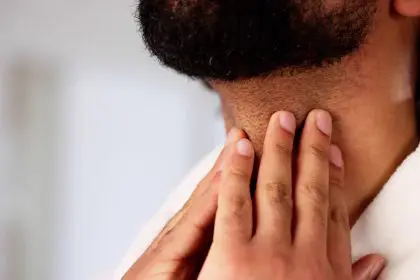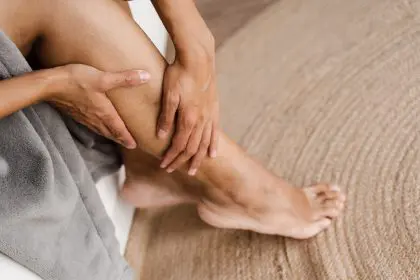You reach for your coffee mug in the morning and notice your fingers feel unusually stiff and achy. You shake your hands a bit, attribute it to sleeping in an odd position, and go about your day. But that subtle morning stiffness might actually be your body’s first whisper of arthritis, long before the condition becomes obvious or debilitating.
When normal aging isn’t so normal
That creaking feeling in your knuckles when you first wake up is easy to dismiss as just another sign of getting older. After all, doesn’t everyone develop a few creaks and groans with age? While some joint changes are indeed part of normal aging, certain patterns of finger stiffness deserve closer attention.
Morning stiffness that lasts longer than 30 minutes suggests inflammatory processes at work rather than simple overnight joint fluid thickening. Pay particular attention if this stiffness improves with movement and warm showers but returns after periods of inactivity. This cycle of stiffness followed by improvement is characteristic of early inflammatory arthritis rather than typical age-related changes.
Another key distinction lies in which fingers are affected. Stiffness primarily in the middle finger and thumb of your dominant hand might simply reflect overuse from writing or computer work. But when stiffness appears symmetrically in both hands, particularly in the middle and end joints of multiple fingers, the pattern aligns more closely with early arthritis development.
The surprising arthritis types you might not know
Most people immediately think of osteoarthritis, the wear-and-tear variety that develops gradually with age. But stiff fingers sometimes signal other forms of arthritis that benefit from very different treatments and respond best to early intervention.
Rheumatoid arthritis typically announces itself through symmetric stiffness in the small joints of the hands and feet. This autoimmune condition causes your immune system to mistakenly attack joint linings, creating inflammation that eventually damages joints. Morning stiffness that lasts an hour or more, especially when accompanied by unusual fatigue, can be an early warning sign years before more obvious joint damage occurs.
Psoriatic arthritis, another autoimmune form, sometimes begins with finger stiffness before skin symptoms appear. This type often causes distinctive swelling that gives fingers a sausage-like appearance, particularly in the end joints. You might also notice subtle changes in your fingernails, such as tiny pits or ridges, which frequently accompany this form of arthritis.
Less common types like gout can also manifest as finger stiffness, though they typically cause more sudden, intense symptoms in one joint at a time rather than the gradual, symmetric stiffness characteristic of other forms. The distinction matters tremendously for proper treatment.
The inflammation connection you can’t see
Beneath the surface of stiff fingers lies inflammation, the common denominator across most arthritis types. This process begins subtly, with low-level immune activity in the joint lining that you might feel as mild morning stiffness long before visible swelling appears.
When inflammation persists, it triggers a cascade of events that eventually damages cartilage and bone. The early stages of this process often produce few symptoms beyond morning stiffness and perhaps mild achiness after activities like opening jars or typing. By the time obvious swelling and significant pain develop, the inflammatory process has typically been active for months or even years.
This explanation helps clarify why early treatment matters so much. Medications that target inflammation work best when started before significant joint damage has occurred. The stiffness you feel today might be your only opportunity to intervene while your joints are still largely intact.
When weather really does predict your pain
That folk wisdom about feeling weather changes in your joints appears to have scientific merit. Changes in barometric pressure can indeed affect joint tissues, particularly when underlying inflammation is present. If your fingers consistently feel stiffer on rainy or cold days, this weather sensitivity offers another clue that early arthritis might be developing.
The mechanism involves pressure changes affecting already inflamed tissues. When barometric pressure drops before storms, tissues can expand slightly, increasing pressure within joints that are already experiencing low-level inflammation. This subtle pressure change goes unnoticed in healthy joints but can trigger increased stiffness in those with early arthritis.
This weather sensitivity often appears before other arthritis symptoms become obvious, making it another potential early warning sign worth noting. If you consistently notice that your fingers predict rain more accurately than your local meteorologist, consider mentioning this pattern to your healthcare provider.
Grip strength tells the hidden story
Before you notice significant pain or visible joint changes, subtle decreases in grip strength might signal early arthritis. You might find yourself asking for help opening jars more often, struggling with buttons on clothing, or noticing that holding heavy shopping bags feels more challenging than it once did.
These functional changes reflect inflammatory effects on the tendons and muscles surrounding finger joints, not just the joints themselves. Inflammation doesn’t stay neatly contained within joint capsules but affects surrounding tissues as well, compromising the complex system that gives your hands their remarkable dexterity and strength.
Simple home observations can help you track these changes. Notice whether you’ve begun adapting how you perform routine tasks without consciously deciding to do so. Perhaps you’ve switched to slip-on shoes to avoid tying laces, begun using two hands to lift items you once managed with one, or found yourself reaching for ergonomic tools in the kitchen more frequently.
The gut-joint connection nobody talks about
Emerging research suggests that for many people, arthritis begins not in the joints but in the gut. The microbiome, that community of trillions of bacteria living in your digestive system, appears to play a crucial role in regulating immune function throughout the body, including in your joints.
Changes in gut bacteria diversity and balance can trigger systematic inflammation that eventually manifests as joint symptoms. This explains why many people with inflammatory arthritis report digestive symptoms months or years before joint problems develop. Recurrent bloating, alternating constipation and diarrhea, or unusual food sensitivities might accompany those stiff fingers, creating a more complete picture of underlying immune dysfunction.
This gut-joint connection helps explain why dietary changes sometimes improve arthritis symptoms. Anti-inflammatory diets rich in omega-3 fatty acids, antioxidants, and fiber appear to modify the microbiome in ways that can reduce overall inflammation, potentially slowing arthritis progression when implemented early.
Beyond the typical risk factors
While age, genetics, and previous joint injuries remain the most recognized arthritis risk factors, research increasingly identifies other contributors that might explain stiff fingers in otherwise low-risk individuals.
Stress appears to amplify inflammation throughout the body, including in finger joints. During periods of chronic stress, inflammatory markers increase systemically, potentially accelerating arthritis development in susceptible individuals. This connection helps explain why finger stiffness sometimes first appears or worsens during particularly stressful life periods.
Sleep quality also significantly impacts inflammation levels. Poor sleep increases cytokines and other inflammatory compounds that affect joint tissues. If your finger stiffness coincides with a period of disrupted sleep, the connection might not be coincidental but rather reflect how sleep disturbances promote joint inflammation.
Certain occupations involving repetitive hand movements naturally increase arthritis risk. Musicians, hairstylists, dental hygienists, massage therapists, and heavy computer users all experience higher rates of hand arthritis. If your work falls into these categories, even mild finger stiffness warrants attention as a potential early warning sign.
Simple interventions with powerful impacts
Addressing finger stiffness early, before significant joint damage occurs, offers your best chance of preserving hand function and preventing disability. Gentle range-of-motion exercises performed daily, particularly after warming the hands, help maintain joint mobility and nourish cartilage.
Anti-inflammatory foods like fatty fish, colorful fruits and vegetables, nuts, and olive oil provide natural compounds that can moderate inflammatory processes. Making these dietary shifts early, when stiffness first appears, may help slow progression more effectively than waiting until joint damage is extensive.
Maintaining healthy weight significantly reduces stress on all joints, including those in the hands. Each extra pound increases inflammation throughout the body, not just in weight-bearing joints, through fat tissue’s production of inflammatory compounds. Even modest weight loss can improve inflammatory markers and potentially slow arthritis development.
The morning stiffness you feel today might be your earliest opportunity to intervene in a process that, left unchecked, can eventually compromise your independence and quality of life. By recognizing these subtle warnings and taking action early, you give yourself the best possible chance of maintaining hand function for decades to come.


















